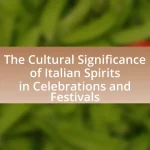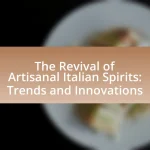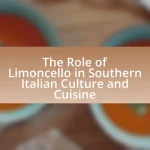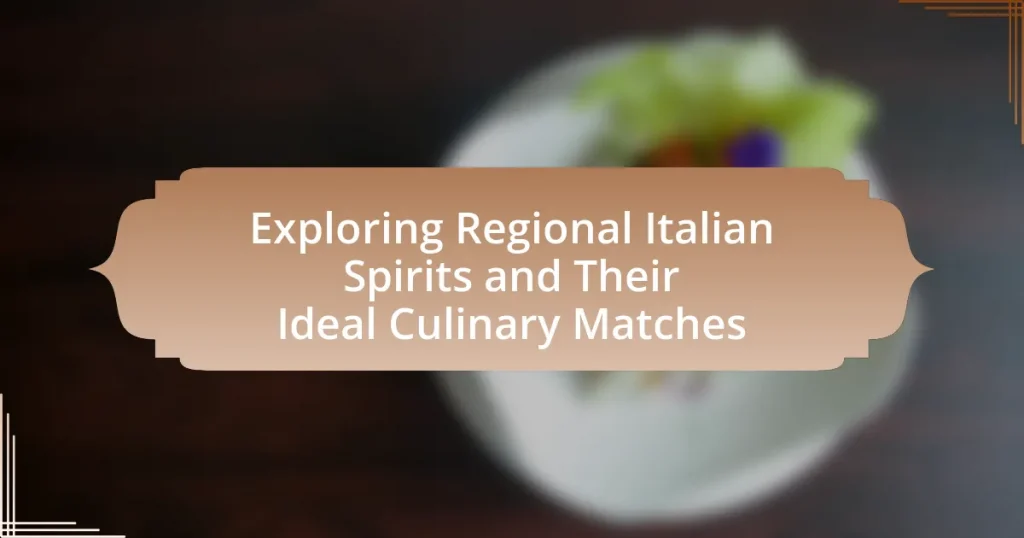Regional Italian spirits are alcoholic beverages that originate from specific regions of Italy, each showcasing local traditions, ingredients, and production methods. This article categorizes these spirits, such as Grappa, Limoncello, and Amaro, based on their geographical origin and unique characteristics. It explores the significance of these spirits in Italian culture, their historical influences, and the variations in production methods across different regions. Additionally, the article provides insights into the ideal culinary pairings for each spirit, emphasizing how flavor profiles and serving temperatures enhance the overall tasting experience.
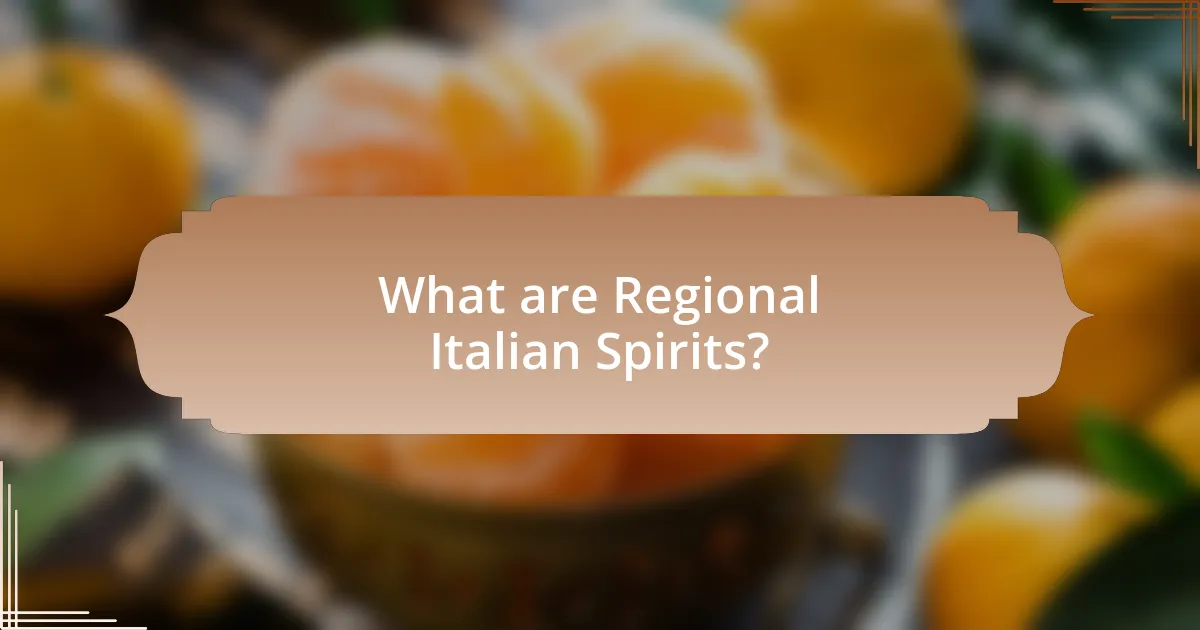
What are Regional Italian Spirits?
Regional Italian spirits are alcoholic beverages that originate from specific regions of Italy, each reflecting local traditions, ingredients, and production methods. Examples include Grappa from the northern regions, Limoncello from the Amalfi Coast, and Amaro from various areas, showcasing unique flavors and cultural significance. These spirits often utilize local botanicals, fruits, or grains, contributing to their distinct characteristics and regional identities.
How are Regional Italian Spirits categorized?
Regional Italian spirits are categorized primarily based on their geographical origin, production methods, and the ingredients used. Each region in Italy has its own unique spirits, such as grappa from the North, limoncello from the South, and amaro from various areas, reflecting local traditions and agricultural products. For instance, grappa is made from grape pomace, while limoncello is produced using lemons from the Amalfi Coast. This categorization is supported by the Italian law governing spirits, which recognizes specific regional products and their distinct characteristics, ensuring authenticity and quality.
What are the key characteristics of each category of Regional Italian Spirits?
Regional Italian spirits can be categorized into several key types, each with distinct characteristics. Grappa, a pomace brandy, is known for its strong flavor derived from grape skins, often enjoyed as a digestif. Limoncello, a lemon liqueur from the Amalfi Coast, is characterized by its sweet, citrusy taste and is typically served chilled. Amaro, a herbal liqueur, varies widely in flavor profiles, often featuring bitter and sweet notes, and is commonly consumed after meals for digestion. Sambuca, an anise-flavored liqueur, is recognized for its strong licorice flavor and is often served with coffee beans. Lastly, Vermouth, a fortified wine flavored with various botanicals, is used in cocktails and has a range of sweetness levels. Each spirit reflects the regional ingredients and traditions of its origin, contributing to Italy’s rich culinary heritage.
How do the production methods vary across different regions?
Production methods for Italian spirits vary significantly across regions due to local ingredients, climate, and traditional practices. For example, in the northern regions like Trentino-Alto Adige, grappa is often produced using a cold maceration process that preserves the aromatic qualities of the grapes, while in the southern regions such as Sicily, the production of Marsala wine involves a unique aging process that incorporates the use of heat to enhance flavor. Additionally, the use of indigenous grape varieties and local herbs in regions like Tuscany for producing Vin Santo showcases how regional characteristics influence production techniques. These variations reflect the cultural heritage and agricultural practices specific to each area, resulting in distinct flavor profiles and production methods.
Why are Regional Italian Spirits significant in Italian culture?
Regional Italian spirits are significant in Italian culture because they embody the unique traditions, flavors, and identities of various regions across Italy. Each spirit, such as grappa from the north or limoncello from the south, reflects local ingredients, historical practices, and cultural heritage, serving as a symbol of regional pride. For instance, grappa, made from grape pomace, has roots in the winemaking traditions of northern Italy, while limoncello, crafted from Sorrento lemons, showcases the agricultural bounty of the Amalfi Coast. These spirits not only enhance culinary experiences but also foster community and connection among people, making them integral to social rituals and celebrations throughout the country.
What historical factors have influenced the development of these spirits?
The development of regional Italian spirits has been significantly influenced by historical factors such as local agricultural practices, trade routes, and cultural exchanges. For instance, the cultivation of specific grapes and herbs in various regions led to the creation of distinct spirits like Grappa in the north, which utilizes pomace from winemaking, and Limoncello in the south, made from locally grown lemons. Additionally, the influence of trade routes during the Renaissance facilitated the introduction of spices and distillation techniques from other cultures, enriching the flavor profiles of these spirits. Historical events, such as the unification of Italy in the 19th century, also played a role in standardizing and promoting regional spirits, allowing them to gain recognition beyond their local origins.
How do Regional Italian Spirits reflect local traditions and customs?
Regional Italian spirits embody local traditions and customs through their unique ingredients, production methods, and cultural significance. For instance, grappa, a spirit made from grape pomace, is deeply rooted in the winemaking regions of Italy, reflecting the agricultural practices and heritage of areas like Piedmont and Veneto. Additionally, amaro, a herbal liqueur, varies by region, with each recipe incorporating local herbs and botanicals, showcasing the biodiversity and culinary practices of that area. The consumption of these spirits often aligns with local rituals and social gatherings, reinforcing community bonds and cultural identity. For example, in Southern Italy, limoncello is traditionally served after meals, highlighting the region’s citrus cultivation and the importance of hospitality. Thus, regional Italian spirits serve as a tangible representation of the customs, agricultural practices, and social traditions unique to their locales.
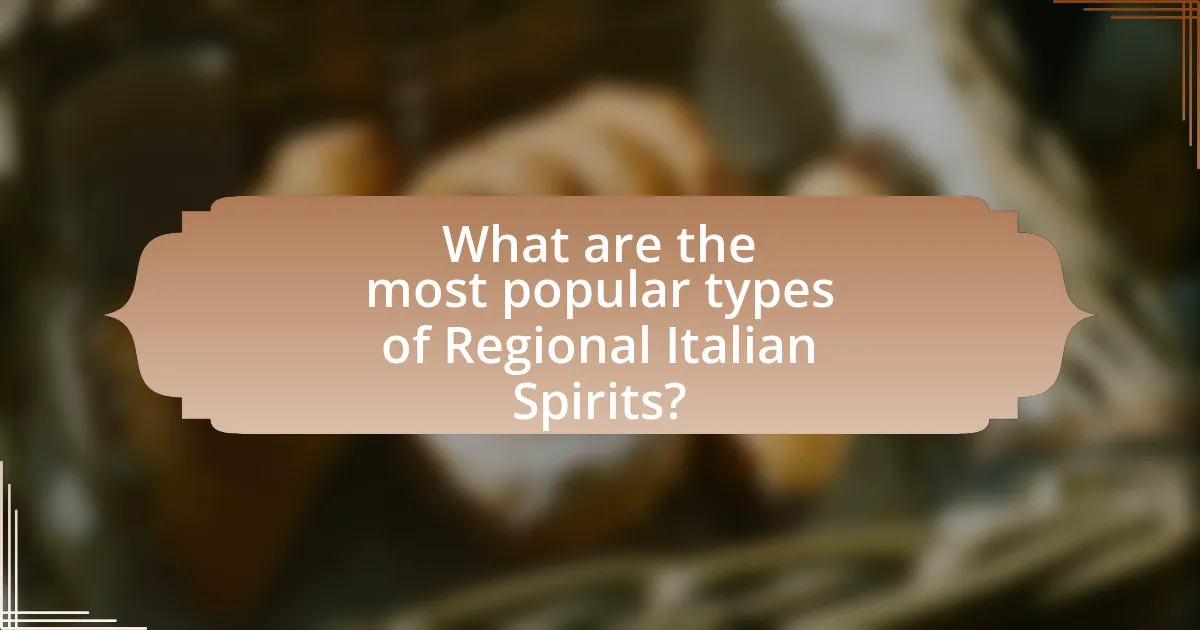
What are the most popular types of Regional Italian Spirits?
The most popular types of Regional Italian Spirits include Grappa, Limoncello, Amaro, and Vermouth. Grappa, a pomace brandy, is widely produced in northern Italy, particularly in regions like Piedmont and Veneto, and is known for its strong flavor derived from grape skins. Limoncello, a lemon liqueur, originates from the Amalfi Coast and is celebrated for its refreshing citrus taste. Amaro, a bitter herbal liqueur, varies by region, with notable varieties like Amaro Montenegro from Emilia-Romagna and Fernet-Branca from Lombardy, each offering unique flavor profiles. Vermouth, a fortified wine flavored with botanicals, is particularly associated with Turin and is essential in classic cocktails. These spirits reflect Italy’s diverse regional traditions and culinary heritage.
What are the defining features of Grappa?
Grappa is a distinct Italian spirit characterized by its production from grape pomace, which includes the skins, seeds, and stems left over after winemaking. This unique method of distillation results in a high alcohol content, typically ranging from 37.5% to 60% ABV, and a robust flavor profile that can vary significantly based on the grape variety used. Grappa is often enjoyed as a digestif and is known for its aromatic qualities, which can include floral, fruity, and herbal notes, depending on the specific ingredients and distillation process. The spirit’s authenticity is protected by Italian law, requiring it to be produced in Italy and adhere to specific production standards.
How is Grappa produced and what are its flavor profiles?
Grappa is produced through the distillation of pomace, which is the solid remains of grapes after winemaking, including skins, seeds, and stems. The process begins with the fermentation of pomace, followed by distillation in pot stills or column stills, typically at a low temperature to preserve the aromatic compounds. The resulting spirit is then aged in various types of containers, such as stainless steel or wooden barrels, which can influence its flavor profile.
The flavor profiles of Grappa can vary widely depending on the grape variety used, the distillation method, and the aging process. Common flavor notes include fruity, floral, and herbal characteristics, with some grappas exhibiting hints of spice or nuttiness. For example, Grappa made from aromatic grape varieties may have pronounced floral notes, while those distilled from more robust grapes can present a richer, more complex flavor.
What dishes pair well with Grappa?
Grappa pairs well with rich, flavorful dishes such as aged cheeses, chocolate desserts, and grilled meats. The high alcohol content and complex flavors of Grappa complement the intensity of these foods, enhancing the overall dining experience. For instance, aged cheeses like Parmigiano-Reggiano or Gorgonzola provide a savory contrast to the spirit’s sweetness, while dark chocolate desserts can balance its bitterness. Additionally, grilled meats, particularly those seasoned with herbs, harmonize with Grappa’s aromatic profile, making it an ideal pairing for a robust meal.
What makes Amaro unique among Italian spirits?
Amaro is unique among Italian spirits due to its complex blend of bitter and herbal flavors, which are derived from a variety of botanicals, roots, and spices. This distinctive flavor profile sets Amaro apart from other Italian spirits like grappa or limoncello, which typically focus on sweetness or fruitiness. The production process often involves macerating these ingredients in alcohol, allowing for a wide range of regional variations, each with its own unique taste and character. For instance, Amaro Averna from Sicily is known for its sweet and citrus notes, while Fernet-Branca from Milan is characterized by its intense bitterness and medicinal qualities. This diversity in flavor and production methods contributes to Amaro’s status as a versatile digestif, enjoyed both neat and in cocktails, making it a standout in the landscape of Italian spirits.
What are the different styles of Amaro and their flavor notes?
Amaro is a category of Italian herbal liqueurs that varies in style and flavor notes, primarily categorized into four main types: Amaro Classico, Amaro Aromatico, Amaro Bitter, and Amaro Dolce.
Amaro Classico typically features a balanced profile of bitter and sweet flavors, often with herbal, citrus, and spice notes, making it versatile for sipping or mixing. Amaro Aromatico is characterized by a more pronounced aromatic quality, often infused with floral and fruity elements, providing a complex and fragrant experience. Amaro Bitter is known for its intense bitterness, often derived from ingredients like gentian and wormwood, appealing to those who prefer a more robust flavor. Lastly, Amaro Dolce is sweeter, with a rich, syrupy texture and flavors of caramel, vanilla, and dried fruits, catering to those who enjoy a smoother, dessert-like finish.
These styles reflect the diverse regional traditions of Italy, with each amaro often showcasing local botanicals and ingredients, contributing to their unique flavor profiles.
Which culinary matches enhance the experience of Amaro?
Culinary matches that enhance the experience of Amaro include rich cheeses, dark chocolate, and herbal dishes. These pairings complement the complex flavors of Amaro, which often features bitter, sweet, and herbal notes. For instance, aged cheeses like Parmigiano-Reggiano or Gorgonzola provide a savory contrast that balances Amaro’s bitterness. Dark chocolate, particularly varieties with high cocoa content, enhances the sweetness and depth of the spirit. Additionally, dishes seasoned with herbs, such as roasted meats or vegetable preparations, align well with Amaro’s botanical elements, creating a harmonious dining experience.

How can one best enjoy Regional Italian Spirits with food?
To best enjoy Regional Italian Spirits with food, one should pair specific spirits with complementary dishes that enhance their flavors. For example, Grappa, a popular Italian spirit, pairs well with rich cheeses and desserts, as its strong, aromatic profile balances the creaminess of the cheese and the sweetness of desserts. Similarly, Amaro, a herbal liqueur, is often enjoyed after meals with chocolate or coffee, as its bitterness contrasts nicely with these flavors, aiding digestion. This pairing approach is supported by the tradition of Italian dining, where spirits are not just beverages but integral components of the meal experience, enhancing both the food and the drink.
What are the general principles for pairing spirits with food?
The general principles for pairing spirits with food involve balancing flavors, enhancing the dining experience, and considering the characteristics of both the spirit and the dish. Pairing should focus on matching the intensity of the spirit with the richness of the food; for example, a robust spirit like grappa complements hearty dishes, while lighter spirits like limoncello pair well with delicate seafood. Additionally, contrasting flavors can create harmony; a sweet spirit can balance savory or spicy dishes. The temperature and serving method of the spirit also play a crucial role, as chilled spirits can refresh the palate between bites. These principles are supported by culinary traditions that emphasize the synergy between food and drink, enhancing both through thoughtful pairing.
How do flavor profiles influence pairing decisions?
Flavor profiles significantly influence pairing decisions by guiding the selection of complementary or contrasting tastes that enhance the overall dining experience. For instance, a spirit with a citrus flavor profile, such as limoncello, pairs well with light seafood dishes, as the acidity of the citrus cuts through the richness of the fish, creating balance. Conversely, a robust spirit like grappa, which has earthy and herbal notes, may be paired with rich, hearty dishes such as braised meats, where the complexity of flavors can stand up to the intensity of the food. This approach is supported by the principle of flavor matching, which suggests that similar or contrasting flavors can enhance the perception of both the food and the drink, leading to a more harmonious meal.
What role does the serving temperature play in the pairing process?
Serving temperature significantly influences the pairing process by enhancing or diminishing the flavors and aromas of both the food and the beverage. For instance, serving white wines chilled accentuates their crispness and acidity, making them more complementary to lighter dishes such as seafood or salads. Conversely, red wines are typically served at a slightly warmer temperature, which allows their tannins and complex flavors to be more pronounced, thus pairing well with richer foods like red meats. Research indicates that temperature affects the perception of taste; a study published in the Journal of Sensory Studies found that cooler temperatures can suppress sweetness and enhance acidity, while warmer temperatures can amplify sweetness and body. This interplay of temperature and flavor is crucial in achieving harmonious culinary matches.
What are some specific pairing recommendations for popular Regional Italian Spirits?
Specific pairing recommendations for popular Regional Italian Spirits include pairing Grappa with dark chocolate or strong cheeses, as the spirit’s high alcohol content complements the richness of these foods. For Limoncello, pairing it with fresh berries or light desserts enhances its citrus notes, making for a refreshing combination. Amaro, known for its herbal bitterness, pairs well with rich meats or aged cheeses, balancing the flavors effectively. Lastly, Fernet is often enjoyed with coffee or chocolate desserts, as its complex flavor profile complements the sweetness and bitterness of these items. These pairings are rooted in traditional Italian culinary practices, enhancing the overall tasting experience.
How can Grappa be paired with traditional Italian dishes?
Grappa can be paired with traditional Italian dishes by complementing the flavors of rich, hearty meals and enhancing the experience of lighter fare. For instance, Grappa’s strong, aromatic profile works well with robust dishes like osso buco or rich risottos, as the spirit’s intensity balances the richness of the food. Additionally, Grappa can serve as a digestif after meals, aiding digestion and providing a pleasant finish to lighter dishes such as seafood pasta or antipasti. The traditional practice of serving Grappa with dessert, particularly with fruit-based desserts or cheeses, further highlights its versatility in Italian cuisine. This pairing tradition is rooted in Italian culture, where Grappa is often enjoyed as a way to conclude a meal, enhancing the overall dining experience.
What are the best food pairings for Amaro to enhance its flavors?
The best food pairings for Amaro include rich cheeses, dark chocolate, and cured meats. These pairings enhance Amaro’s complex flavors, as the bitterness and herbal notes of the spirit complement the saltiness of cheeses like Parmigiano-Reggiano and the richness of aged Gouda. Dark chocolate, particularly varieties with high cocoa content, balances Amaro’s sweetness and bitterness, creating a harmonious tasting experience. Cured meats, such as prosciutto and salami, provide a savory contrast that highlights the herbal characteristics of Amaro. These combinations are rooted in traditional Italian dining practices, where Amaro is often enjoyed as a digestif alongside these foods to stimulate digestion and enhance the overall meal experience.
What tips can enhance the experience of enjoying Regional Italian Spirits?
To enhance the experience of enjoying Regional Italian Spirits, one should focus on proper serving temperature, glassware selection, and food pairings. Serving spirits at their ideal temperature, such as grappa at room temperature or limoncello chilled, allows for optimal flavor release. Choosing appropriate glassware, like a tulip-shaped glass for aromatic spirits, helps concentrate the aromas, enhancing the tasting experience. Additionally, pairing these spirits with regional foods, such as enjoying amaro with dark chocolate or grappa with cheese, complements the flavors and elevates the overall enjoyment. These practices are supported by traditional Italian customs that emphasize the importance of sensory experience in spirit consumption.
